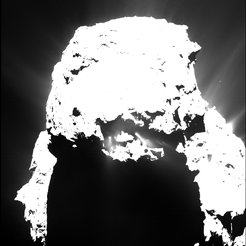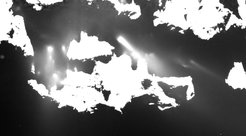Sunset Jets on Rosetta’s Comet
Even after nightfall Rosetta’s comet 67P/Churyumov-Gerasimenko remains active and emits dust jets into space.
When night falls on Rosetta’s comet 67P/Churyumov-Gerasimenko, the bizarrely shaped body remains active. This can be seen in new images of the Ma’at region located on the comet’s “head” captured by OSIRIS, the scientific imaging system on board the Rosetta spacecraft. They were taken approximately half an hour after the Sun had set over the region and show clearly distinguishable jets of dust escaping into space. Researchers from the OSIRIS team believe that the increasing heating-up of the comet is responsible for the newly observed phenomenon.

"Only recently have we begun to observe dust jets persisting even after sunset”, says OSIRIS Principal Investigator Holger Sierks from the Max Planck Institute for Solar System Research (MPS) in Germany. In the past months, the comet’s activity originated from illuminated areas on the day side. As soon as the Sun set, these jets subsided and did not re-awake until after the next sunrise. An exception poses an image from 12 March, 2015 showing the onset of a dust jet on the brink of dawn.
According to OSIRIS scientists, the jets now occurring even after sunset are another sign of the comet’s increasing activity. “Currently, 67P is rapidly approaching perihelion in mid-August”, says Sierks. At the time the image was taken, comet and Sun were only 270 million kilometers apart. “The solar irradiation is getting more and more intense, the illuminated surface warmer and warmer”, Sierks adds.

First analyses suggest that the comet can store this heat for some time beneath its surface. "While the dust covering the comet’s surface cools rapidly after sunset, deeper layers remain warm for a longer period of time," says OSIRIS scientist Xian Shi from the MPS, who examines the sunset jets. In these layers Rosetta scientists suspect the supply of frozen gases, which fuels the comet’s activity.
Older comet missions, too, like Stardust to comet 81P/Wild 2 and Deep Impact comet 9P/Tempel 1 had found evidence of jets sustained on the night side. "But only the high-resolution images of OSIRIS now allow us to study this phenomenon in detail," says Sierks.
Rosetta is an ESA mission with contributions from its member states and NASA. Rosetta's Philae lander is provided by a consortium led by DLR, MPS, CNES and ASI. Rosetta is the first mission in history to rendezvous with a comet, escort it as it orbits the Sun, and deploy a lander to its surface.
The scientific imaging system OSIRIS was built by a consortium led by the Max Planck Institute for Solar System Research (Germany) in collaboration with CISAS, University of Padova (Italy), the Laboratoire d'Astrophysique de Marseille (France), the Instituto de Astrofísica de Andalucia, CSIC (Spain), the Scientific Support Office of the European Space Agency (The Netherlands), the Instituto Nacional de Técnica Aeroespacial (Spain), the Universidad Politéchnica de Madrid (Spain), the Department of Physics and Astronomy of Uppsala University (Sweden), and the Institute of Computer and Network Engineering of the TU Braunschweig (Germany). OSIRIS was financially supported by the national funding agencies of Germany (DLR), France (CNES), Italy (ASI), Spain (MEC), and Sweden (SNSB) and the ESA Technical Directorate.

